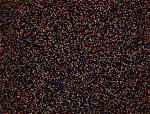What use is the DNA synthesis procedure? The first string was too small to see by eye or any microscope. Having two strings doesn’t really help, given how small they are.
What we can do is make the newly synthesized string easier to observe. We can use chemical modifications so that they generate a signal that can be detected. This can be done by chemically modifying the nucleotides before they are incorporated into a newly synthesized string. In other words, we will have a pool of As that have a signal, a pool of Cs that have a signal, and so on.
Here's how we create this signal: Typically, we attach atoms or molecules that give off light or radiation that can be readily detected. In the old days, we attached radioactive atoms, which gave off radiation that was detectable on X-ray film. Now, we use fluorescent dyes that glow in different colors when illuminated with the right kind of light. So we might get something like this:
5’-ACCGTACGTTGC-3’
3’-TGGCATGCAACG-5’
Imagine you are trying to read a book from 1,000 yards away—a distance of 10 football fields. You try to use binoculars but the letters are too small—in fact, you have a hard time seeing the book itself. But if the letters in the book glow with light and if the light is bright enough, you should be able to see the light from the book.
To tell the nucleotides apart from each other, we make sure each nucleotide has a unique color signal. Of course, if we looked at the string above, it would generate a mixture of the four different colors and we would be confused. It is like the book at 1,000 yards with each letter glowing with a different color. You would see mixed-color light, but you would still not be able to see different-colored lights attached to individual letters. We have to solve this problem first to then solve the problem of sequencing.


 Discovering the Genome
Discovering the Genome